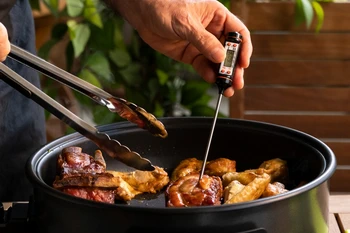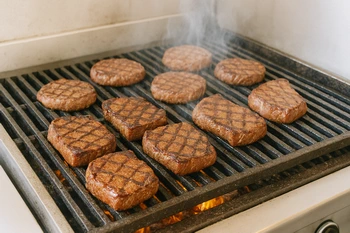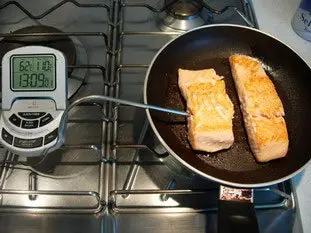This site uses only a few technical cookies necessary for its operation. By continuing to browse, you accept their use.
To find out more...
To find out more...
The thermometer is your friend

There are many recipes or foods that require a (very) precise cooking temperature: foie gras, sugar for caramel, meats and fish, and not forgetting pastries. For these few examples, getting the cooking temperature wrong can spoil the whole recipe or dish: undercooked, it's no good or misses the mark; overcooked, it can become hard, dry or inedible.
It's not easy to judge cooking or temperature by eye, but fortunately you have an indispensable friend in the form of a thermometer.
It's not easy to judge cooking or temperature by eye, but fortunately you have an indispensable friend in the form of a thermometer.
4,865 5/5 (4 reviews)
Keywords for this post:CookingPastryBakeryTemperatureBakingThermometerElectronicLast modified on: April 10th 2025
The thermometer is your friend
A catering professional has a keen eye, he or she is able to see or sense if the cooking is finished, or if it needs to be continued, simply by virtue of his or her long experience. It's always amazing to see a rotisserie chef, or a rotisserie cooker, who can manage a 1-square-meter griddle, and who is able to start cooking 5 or 6 pieces of meat at the same time, or more, and to know when to stop the "blue", the "rare" and the "medium" at the right moment.
Obviously, this is something we amateurs are hardly capable of. It's not so easy to cook fish properly, and nothing is better than a perfectly cooked fish fillet: neither too much (it dries out and hardens), nor too little (it's not sushi, being "pearly" when cooked isn't always enough).
You might think that it's only a question of time: if you put your tournedos on the stove for x minutes, it will be cooked to perfection, or if you put your roast in the oven for y minutes, it will be too. But no, it doesn't work like that, because the heat source is highly variable: you put your frying pan on the fire, and it takes a certain amount of time to reach the right temperature, depending on your setting; your meat may have just come out of the fridge, so it's cold, which means it will take longer to cook, whereas meat at the right temperature will cook faster, in short... It's almost mission impossible.
So, should we give up? No, in fact, technology can come to our rescue in a very simple way: since cooking means reaching a certain temperature, and this temperature can be measured with a thermometer, we can rest easy enough on that.
Returning to the story of the undercooked fish, it's enough to know that fish is (generally) perfectly cooked if it reaches 60°C at the core. To cook your fish successfully, put it in the oven or on the stove, stick a thermometer probe in it and wait for it to reach the famous 60°C, then remove from the heat and serve within 3 to 5 minutes. You'll be amazed at the results.
It works for just about any type of cooking, and above all, it's completely environmentally friendly: is my oven/oven hot? Is my meat or fish at room temperature or not? Is the thickness of my foie gras even? Is my sugar "grand cassé" rather than blond caramel? None of this matters, only the core temperature of your dish.
If you're going down this road, you'll need a good thermometer: opt for an electronic one that goes up to 300°C, with an oven-safe stainless steel probe (some kitchen ovens now include a probe), and if possible a temperature alarm: it beeps loudly when the indicated temperature is reached, allowing you to do something else while cooking. It's not cheap, but it's a good investment, and once you've tried it, you'll see that it's a life-changing device.
To sum up: when cooking, only the core temperature counts, and the thermometer is ideal for that.

Obviously, this is something we amateurs are hardly capable of. It's not so easy to cook fish properly, and nothing is better than a perfectly cooked fish fillet: neither too much (it dries out and hardens), nor too little (it's not sushi, being "pearly" when cooked isn't always enough).
You might think that it's only a question of time: if you put your tournedos on the stove for x minutes, it will be cooked to perfection, or if you put your roast in the oven for y minutes, it will be too. But no, it doesn't work like that, because the heat source is highly variable: you put your frying pan on the fire, and it takes a certain amount of time to reach the right temperature, depending on your setting; your meat may have just come out of the fridge, so it's cold, which means it will take longer to cook, whereas meat at the right temperature will cook faster, in short... It's almost mission impossible.
So, should we give up? No, in fact, technology can come to our rescue in a very simple way: since cooking means reaching a certain temperature, and this temperature can be measured with a thermometer, we can rest easy enough on that.
Returning to the story of the undercooked fish, it's enough to know that fish is (generally) perfectly cooked if it reaches 60°C at the core. To cook your fish successfully, put it in the oven or on the stove, stick a thermometer probe in it and wait for it to reach the famous 60°C, then remove from the heat and serve within 3 to 5 minutes. You'll be amazed at the results.

It works for just about any type of cooking, and above all, it's completely environmentally friendly: is my oven/oven hot? Is my meat or fish at room temperature or not? Is the thickness of my foie gras even? Is my sugar "grand cassé" rather than blond caramel? None of this matters, only the core temperature of your dish.
If you're going down this road, you'll need a good thermometer: opt for an electronic one that goes up to 300°C, with an oven-safe stainless steel probe (some kitchen ovens now include a probe), and if possible a temperature alarm: it beeps loudly when the indicated temperature is reached, allowing you to do something else while cooking. It's not cheap, but it's a good investment, and once you've tried it, you'll see that it's a life-changing device.

To sum up: when cooking, only the core temperature counts, and the thermometer is ideal for that.
Lasts posts
Butter vs. grease
We often read in a recipe where a pastry is put into a mould that, just before pouring, the mould should be buttered or greased. But what's the difference between these 2 terms?December 1st 20251,2745
Getting out of the fridge early
Very often when you're cooking, you need to take food or preparations out of the fridge, to use them in the recipe in progress. There's nothing tricky about this: you just take them out of the fridge and use them, usually immediately, in the recipe. But is this really a good method?November 24th 20251,2325
Who's making the croissants?
When you look at a bakery from the outside, you naturally think that in the bakery, the bakers make the bread, and in the laboratory, the pastry chefs make the cakes. It's very often like that, with each of these professions having quite different ways of working, but sometimes there's also one...November 23th 20251,117
Oven height
When we put a dish or cake in the oven, we naturally tend to put it on the middle shelf, and that's what we usually do. But in some cases, this position and height can be a little tricky, so let's find out why.October 8th 20253,0725
The importance of sieving
In recipes that use a fine powder (flour, powdered sugar, etc.), you'll often see the advice to sift before using it. To sift is to pass the powder in question through a sieve (a very fine strainer) before incorporating it into your recipe. It's often advice, but is it really useful?September 3rd 20257,7573
Other pages you may also like
Raising (or leavening) agents
When we want to make a dough or batter rise when baking, either in patisserie or bread-making, we need to use a raising agent or leavening agent, one of which is called leaven. In the context of baking, a raising agent is simply what "makes something rise". It is a substance which, when added to...June 16th 202157 K4.8
Candied fruits: don't get ripped off
Do you like candied fruit? You might like to nibble a handful or add it to a recipe, like a classic fruit cake or delicious Italian specialities like panettone or sicilian epiphany pie.June 21th 201767 K 24.2
The "pith" of the cauliflower
When using cauliflower in a recipe, there is a lot of preparation work at the beginning: removing the leaves, taking the tops or florets, etc. It's a bit tedious, but in the end you're left with the best of the cauliflower, ready to be used in your recipe.February 5th 202214 K4.9
Soup vs. potage
It's true that we're finally coming out of winter as I write these lines, and that we'll all be making, no doubt, a little less soup and potages, but even if it's out of season, it really is a simple and delicious dish, which is one of the always easy answers to "What's for dinner this (Sunday)...April 9th 202211 K
Pastry doughs
To make a classic tart, you'll need a pastry of course, and if you don't use puff pastry (normally reserved for "fine", in french, tarts), you'll have a choice of shortcrust, shortbread, sweetcrust or "à foncer". Let's take a look at the differences between these four.August 16th 20248,7204.4
Post a comment or question
Follow this page
If you are interested in this page, you can "follow" it, by entering your email address here. You will then receive a notification immediately each time the page is modified or a new comment is added. Please note that you will need to confirm this following.
Note: We'll never share your e-mail address with anyone else.
Alternatively: you can subscribe to the mailing list of cooling-ez.com , you will receive a e-mail for each new recipe published on the site.









